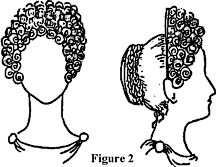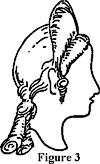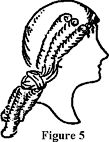Roman Women's Hairstyles
To describe the hairstyles of the roman women is a difficult undertaking. Ovid complained that he could not keep track of fashion. "Every day, so it seems, brings in a different style." The range is from a simple chignon in earilier times to the elaborate built up styles of the late Republic, the later often vying with the pre-french revolution period for height and complication. So possessed were Roman women with fashion that they even had their portrait busts made with removable hairstyles, so that they would always be remembered at the height of fashion.
Curling irons, wire supports, hairnets, hairpins and false hair pieces were all used, as well as setting solutions such as egg white or gum arabic. Wigs were made of the blonde hair of captured Celtic and Gemanic women and dyes were used to change natural colors to blondes and reds, especially popular during some periods. Ovid, that woman watcher, devoted a whole poem to the changing of hair color and its hazzards:
"I told you to stop using that rinse,
And now you've no hair left to tint.
Why couldn't you let it be?...
You've only yourself to blame. You were asking for trouble applying that concoction.
But thanks to our German triumph you're quite safe.
One of the women prisoners can send you hers."
Looking at some of the styles it becomes evident that they were not something Claudia threw together just before going out. They were more often the constructions of slave hairdressers whose lot was not always a happy one. Again from Ovid:
"Let the tiring-woman be safe;
I hate her who tears with her nails her handmaid's face
Or seizing a needle stabs her arms.
That maid curses, as she touches it, her mistress's head,
And weeps the while, bloodstained over the hated locks."
And this isn't an isolated instance of hairdresser harassment, it is a theme that appears in many poems and tales.
The styles in Rome set the fasion for the provinces, although the provinces were certainly behind the times, due to the delay in communication. One wonders how such information was transmitted, whether by dressing dolls as was done in later times, by word of mouth, or by sending slaves trained in the latest arts to the remote corners of the Empire.
Examples:
For earlier times you can put your hair in a chignon or bun at the back of your head. If you dont' have a lot of hair, you can purchase a false hair piece for very little. You can dress it up by braiding the hair before making the bun, or you could surround the bun with a separate braid. The hair should be parted in the middle, and small tendrils can be pulled out around the face and curled (figure 1). This type of style was widely worn in later times as well, as long as you don't profess to be a lady of wealth.
Cypriote curls were the fashion during the late 1rst century a.d. They were piled high around the face on special frames that could either be invisible or decorative (figure 2). The easiest way to achieve this style is to fake it. Use a plastic eyeshade* and cover it with metallic material, paint or leaf. Place it on the head as shown in figure 2a. Attach the curls securely to the front (or glue the hairpiece to the shade first and then place it on your head). The hair in the back is worn in a bun. Use a fake piece again if your hair is lacking in length. Another similar sytle drapes the front hair over the support as shown in figure 3. Again, cover the support and glue false hair to it. The back hair, in this example, is knotted and then curled. Figure 4 shows yet another variation.
*(Editor's note)Plastic Eyeshade: popular in the early 1980's. Also known as a (sun) visor, rather like a rigid hair band with the bill of a baseball cap attached. Look for them in thrift shops, they are usually about 50¢.
Young girls apparently wore their hair in long curls in back with various treatments to the front and sides, such as waves, twists and more curls (figure 5).
A 2nd century style has the front hair parted in the middle and waved, with the back hair braided and pinned to the top of the head. This would be a good style for someone with short hair. Get a braided swatch and fold it in half. Place the fold on top of the head and pin down all the way to the back, securing the ends of your hair underneath. (figure 6)
A third century style for someone with naturally long hair has the hair parted down the middle, then from side to side. (figure 7). The front sections are braided to below the ears and then french-braided into the hair at the back. This is for someone who also has patience and a good friend who knows how to french-braid.
Remember that when out of doors, a married woman would cover her hair with a palla or veil.,/p>
These are just a few examples of the variety of Roman styles. Look for busts and statues of Roman women and examine their hairstyles, with an eye toward replicating.
After the 5th century a.d., the cultural center slowly moved to the Eastern Empire and Byzantium. Next issue will cover the styles of the Byzantium empire.
Sources:
Hadas, Moses and Editors of Time-Life Books Imperial rome. Time-Life Books, 1965.
Hope, Thomas Costumes of the Greeks and Romans. Dover, 1962.
Holum, Kenneth G. Theodosian Empresses: Women and Imperial Dominion in Late Antiquity. University of Califonia Press, 1982.
Houston, Mary Ancient Greek, Roman, and Byzantine Costume. Adam and Charles Black, London, 1931.
Ovid Amores. Translated by Guy Lee. The Viking Press, 1968.

Back to Early Period #4 |
Back to Early Period Index |
Back to PastTimes












